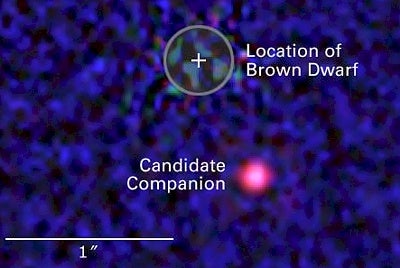A team of American and European astronomers announced today that a “giant planet candidate” imaged near a brown dwarf known as 2M1207A last year is indeed traveling through space with it.
“Our new images show convincingly that this really is a planet, the first planet that has ever been imaged outside of our solar system,” says Gaël Chauvin, an astronomer at the European Southern Observatory (ESO) and leader of the discovery team.
In August 2004, follow-up observations using the Hubble Space Telescope all but clinched the case. Glenn Schneider of the University of Arizona observed 2M1207b with Hubble’s NICMOS infrared camera. In January, he announced that Hubble’s position measurements indicated the object is a true orbiting companion.
“The two objects … are moving together; we have observed them for a year, and the new images essentially confirm our 2004 finding,” says Benjamin Zuckerman, an astronomer at the University of California, Los Angeles, and a member of the ESO team. “I’m more than 99 percent confident.”
“Our discovery represents a first step toward one of the most important goals of modern astrophysics: to characterize the physical structure and chemical composition of giant and, eventually, terrestrial-like planets,” says Anne-Marie Lagrange, a team member from Grenoble Observatory in France.
Glenn Schneider observed the system with Hubble again on April 26 and reported his most recent findings Monday at the Space Telescope Science Institute in Baltimore. He verified the ESO team’s finding that 2M1207b is moving with the brown dwarf. Using a more recent distance determination, he placed the object at 170 light-years away, closer than the previous estimate of 230 light-years. This means the separation between 2M1207b and the brown dwarf is 40 times that between the Earth and the Sun, making its “year” about 1,500 Earth-years long. Because the planet takes so long to orbit, astronomers could not expect to see any change in position for decades, so any positional change would indicate the objects were not moving through space together. He estimates 2M1207b’s mass at between 2 and 5 times that of Jupiter.
Hubble viewed the system through a different color filter last month, expanding on the earlier detection of water vapor, but Schneider notes 2M1207 appeared fainter in the new image. “It’s possibly variable,” he notes. “Perhaps we’re seeing an effect of rotation or clouds.”
Both Schneider and the ESO team concede 2M1207b challenges ideas of planetary formation. “It’s a planetary mass, but is it a planet?” he asks. “I don’t want to put this thing in a box.” It’s possible 2M1207b formed in a process more akin to the way stars and brown dwarfs are made than planets like those in our solar system. In that case, say astronomers, it may constitute a new class of object — “planetary-mass brown dwarf companions.”
The system lies in Centaurus the Centaur and belongs to a loose star cluster called the TW Hydrae association. Astronomers estimate the ages of all objects in this group at about 8 million years. Because 2M1207b and its brown dwarf are so young, they glow brightly in the infrared and are easy to detect. But locating objects like 2M1207b when they’re 10 times older “presents a real detection problem,” says Schneider.
Unlike a star, a brown dwarf lacks the mass to produce energy by nuclear fusion of hydrogen to helium. When young, a brown dwarf can fuse deuterium, a rare isotope of hydrogen, into helium, but otherwise glows from heat produced as a by-product of its gradual contraction. Astronomers usually set the line dividing giant planets and brown dwarfs at 13 Jupiter masses.












